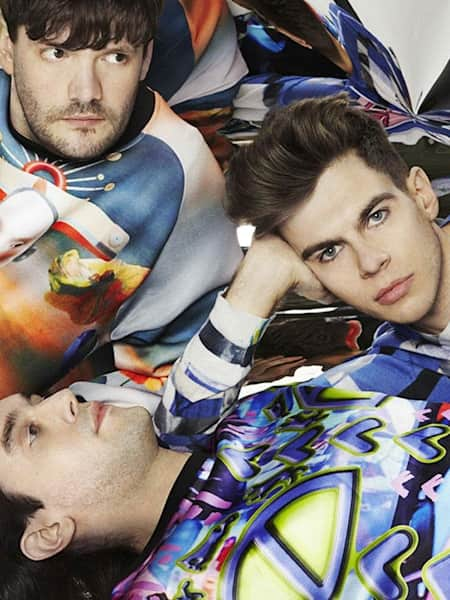Call it funk-punk, call it psychedelic pop, call it new rave: whatever label you stick on it, the Klaxons you think you’ve categorised are about to shake it all up again.
It’s four years since James Righton, Jamie Reynolds and Simon Taylor-Davies released their divisive second album, Surfing The Void, and the London three-piece are back with a new sound and a new lease of life.
The band have been figuring out what Klaxons sound like in a new dance music-dominated landscape. The result is their third album Love Frequency (released today), a record that both captures a cultural moment and returns to the band’s songwriting roots.
Here’s sound-sculptor James Righton (who was recently in the Red Bull Studios Paris with the rest of the band) on the things they learnt during the process.
Don’t rush
“One of the biggest things we learnt was patience, not feeling like you have to release something until you’re all completely happy with what you have,” says James. “There are certain songs on the album we spent almost two years on. We’d say we’d almost finished it after the first couple of days with them, and then two years later [we were] still tweaking everything from snare sounds to whether the chorus should go on a bit longer.”
Step outside of your comfort zone
The biggest difference to be heard in Klaxons is their new-found love of technology. “It was born through the lack of desire to do what we normally do, which is play our instruments. Simon didn’t want to touch a guitar, I didn’t really want to play keys, Jamie didn’t really want to play bass. We literally all learnt different recording programs and music-making software, and a lot of the time we were just sat around a table, sending little ideas and parts to each other that we’d each made on our own laptops.”
Allow room for new voices
“Another way we’d never worked before was we listened to music that Tom [Rowlands, The Chemical Brothers] and Erol [Alkan] had made,” says James. “There was a track from Erol – Rhythm of Life was a demo that he made with Boys Noize – that was just a really good instrumental, and then we kind of turned it into a song.
It was this rejuvenated way of looking at the technical process – but not the essential vibe of the music itself – that gave Klaxons their mojo back when making Love Frequency. Put simply, “[Tom and Erol] don’t sit around playing instruments… It’s not about performance, it’s about sculpting a sound.”
Less is more
That sculpting principle makes the new album way more stripped-back than its predecessor. “We wanted it to be pop, we wanted it to be a little bit less esoteric,” says James. “The last record, we all love it, but it’s quite a dense record. There’s lots of words and lots of dense sounds, so we wanted this one to just be a bit clearer. It has hooks. We always wanted to be a pop band – like a weird, subversive pop band that could get into the charts, but at the same time sing about very abstract things.”
Take note of what’s going on around you...
There’s no escaping the colossal rise of dance music in recent years, and this had an impact on the headspace James, Jamie and Simon found themselves in while writing Love Frequency. James points out, “You couldn’t turn on the radio and not hear Get Lucky. Whether that influenced us or not I don’t know… but it was so omnipresent.
“We’ve now got a kind of hybrid set, where we’re playing our instruments, we are playing live, but we also put electronics into it to give it a bit more weight. Because you do notice sometimes when you see a live act, like a band, after an electronic act with the biggest kick-drum, they sound tiny.”
...Then do the opposite
The best piece of wisdom they have to offer new bands? “Create your own world,” James says without hesitation. “Live, breathe it, and try and make it the complete opposite to what is the most popular thing. Do the opposite of what there is in the world – and then make it into a world. And then try and write some songs around it.”
Want to experience the best of RedBull.com on the move? Get the app at RedBull.com/app.



